On the Trail in
LONE PINE
Backdrop for Hundreds of Classic Westerns

COLIN SIMPSON
YOU may never have heard of the small (pop. 2,035) town of Lone Pine, 320 kilometres north of Los Angeles. But the chances are you’ve seen it and the surrounding area dozens of times on screen. For more than a century, directors, crews and Hollywood’s greatest stars have headed there to shoot some of the best-loved films and TV shows ever made.
They are attracted by the Alabama Hills to the west of the town. Cinematographers love the way the rugged hills, standing east of the Sierra Nevada, fill the frame, providing a striking backdrop to shootouts, chases and other action scenes. Boulder-strewn sites and unusual rock formations provide variety.
Last year saw the centenary of the release of the Western The Round-Up, the first movie to be shot in the area. Lone Pine soon became a favourite location for films about the wild west, though it has also provided backdrops for science fiction epics, comic book blockbusters, thrillers, crime capers, dramas and even sagas about Ancient Rome.
The Internet Movie Database lists no fewer than 502 productions that were shot there. More recent standouts include Gladiator, Iron Man – where it stood in for Afghanistan – Man of Steel, Gone In 60 Seconds, Transformers: Revenge of the Fallen, Chaplin, and two Star Trek films. The many TV series on the list include one of my favourites from the 1960s, The Time Tunnel.
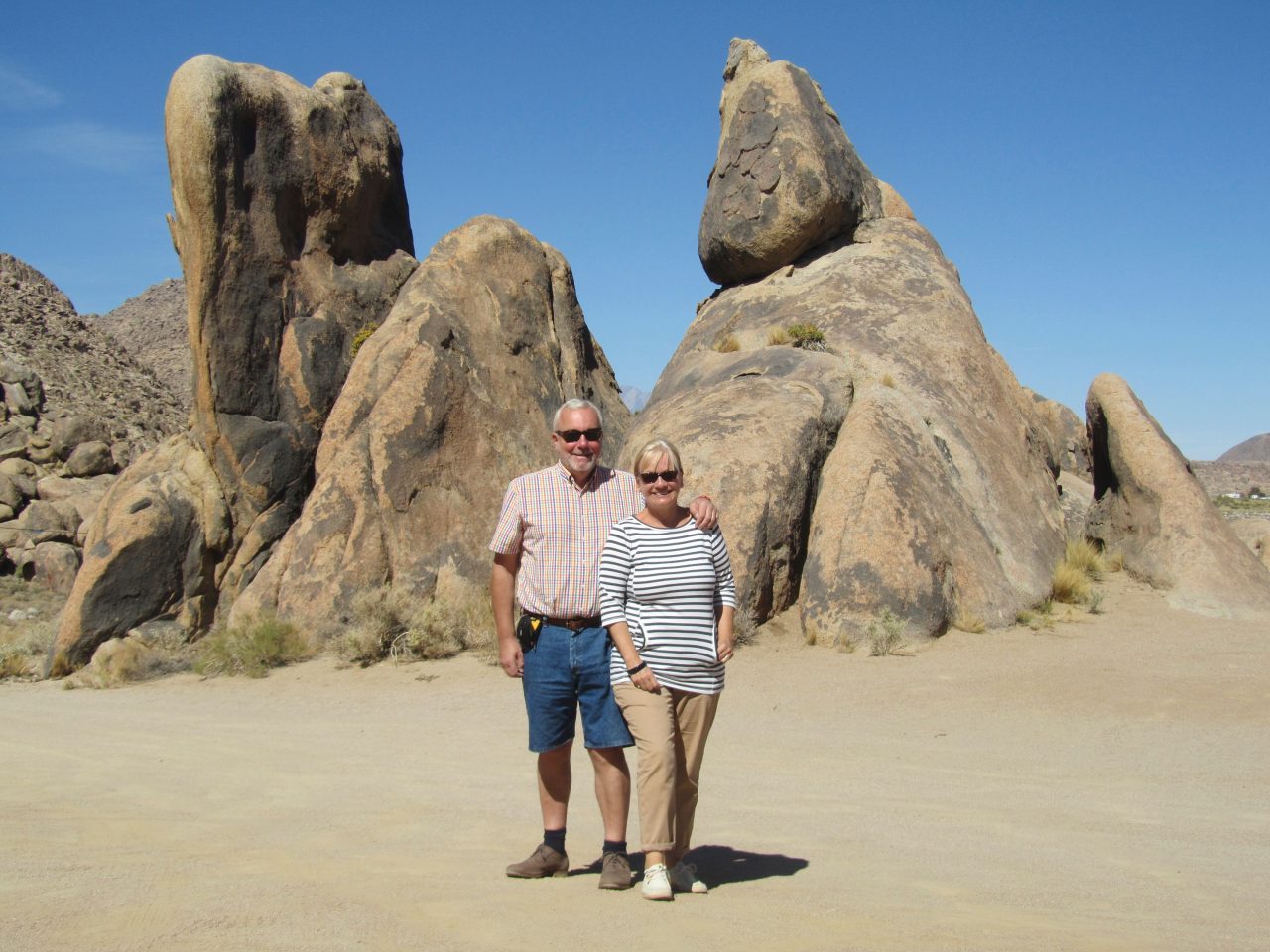
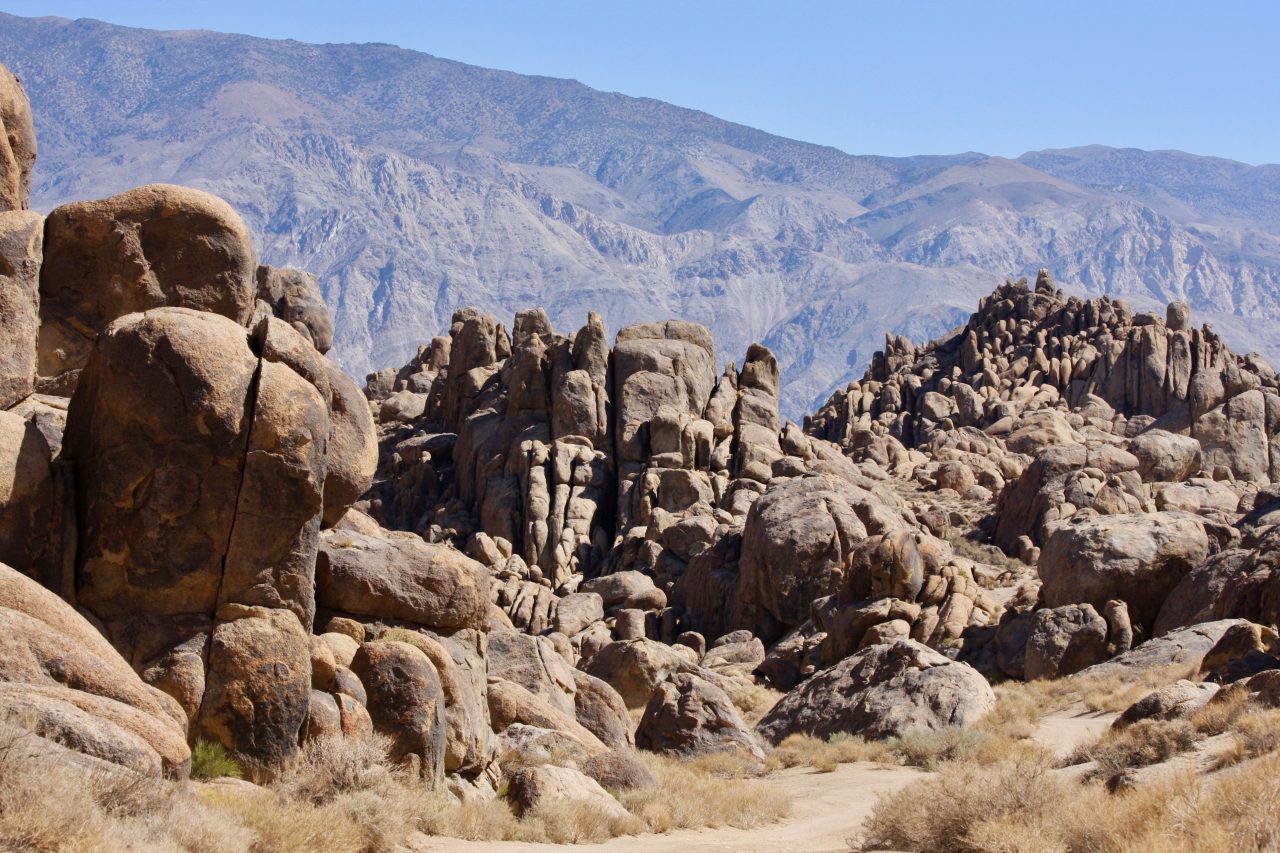
Older classics include 1939’s Gunga Din, where those versatile hills were used to portray the Northwest frontier of India. Stars Cary Grant and Douglas Fairbanks Jr. propelled this comedy adventure to box-office success, and it remains popular 80 years later, scoring 92 percent on Rotten Tomatoes.
A tourist map is available so you can drive around and stop off at sites where parts of particular films were shot.
Another film, 1941’s High Sierra, has an even better ranking, 95 percent, and is the movie that turned Humphrey Bogart into a major star. The climax sees “Mad Dog” Roy Earle, played by Bogart, slide to his death from one of the sierra mountains during a shootout.
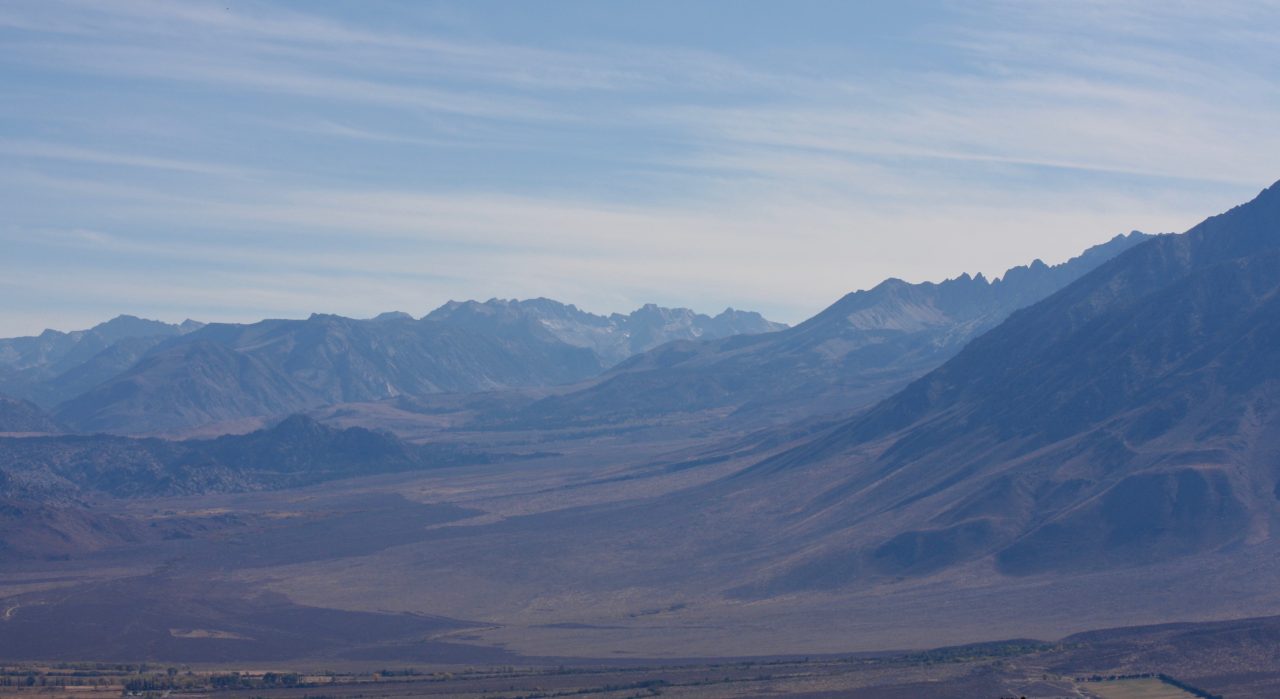
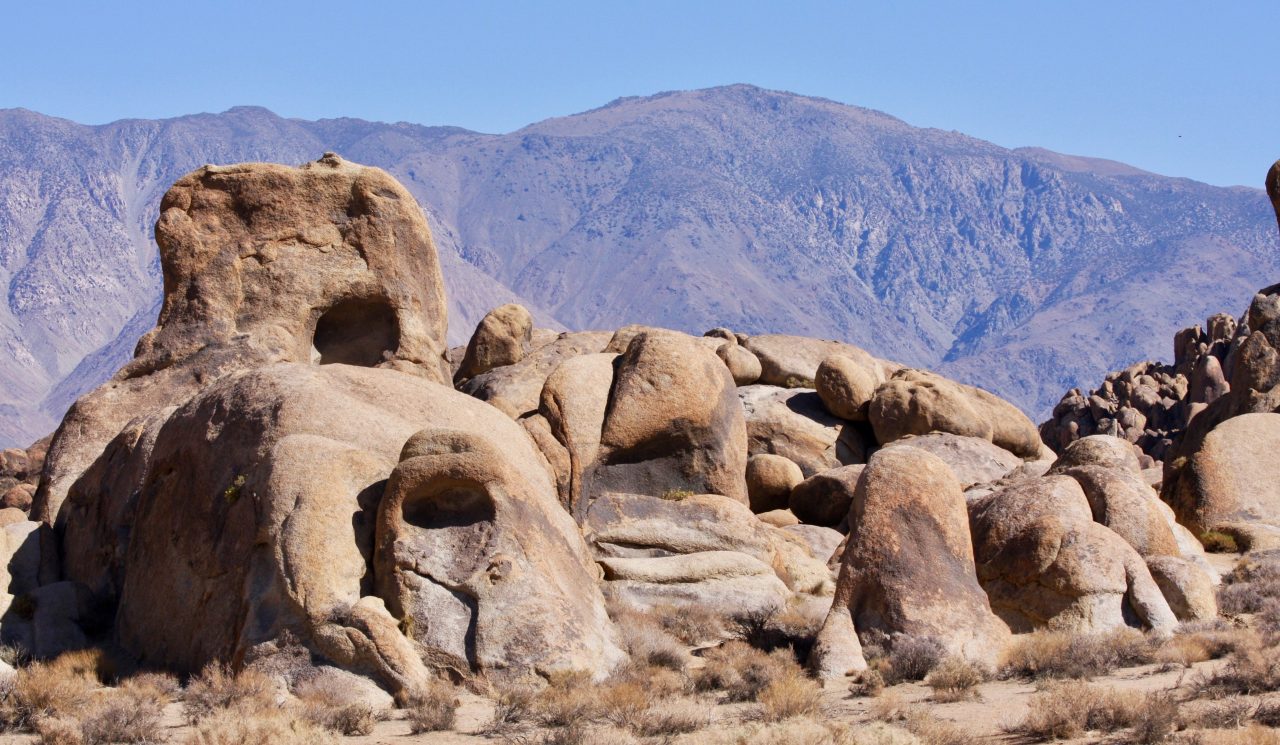
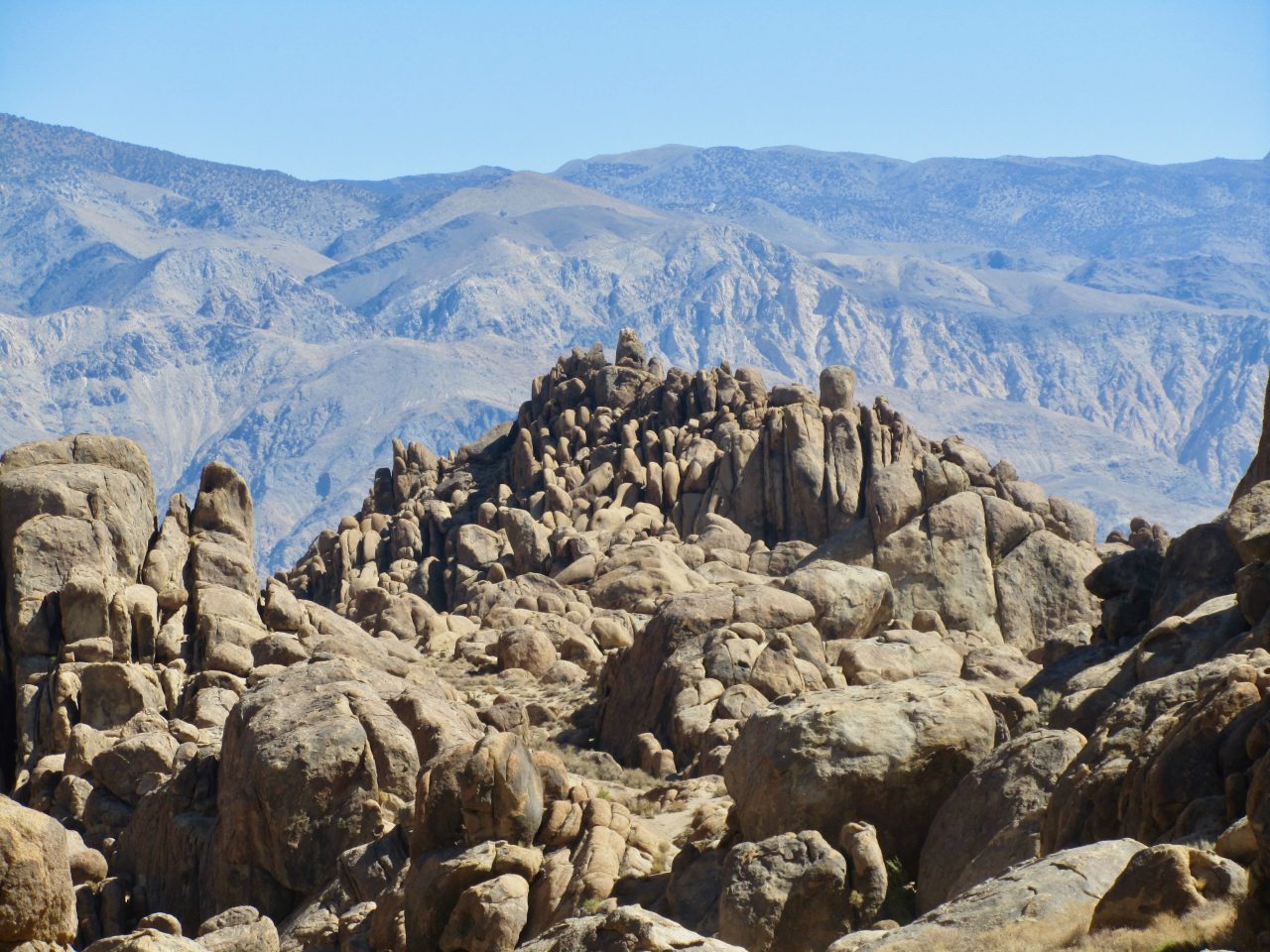
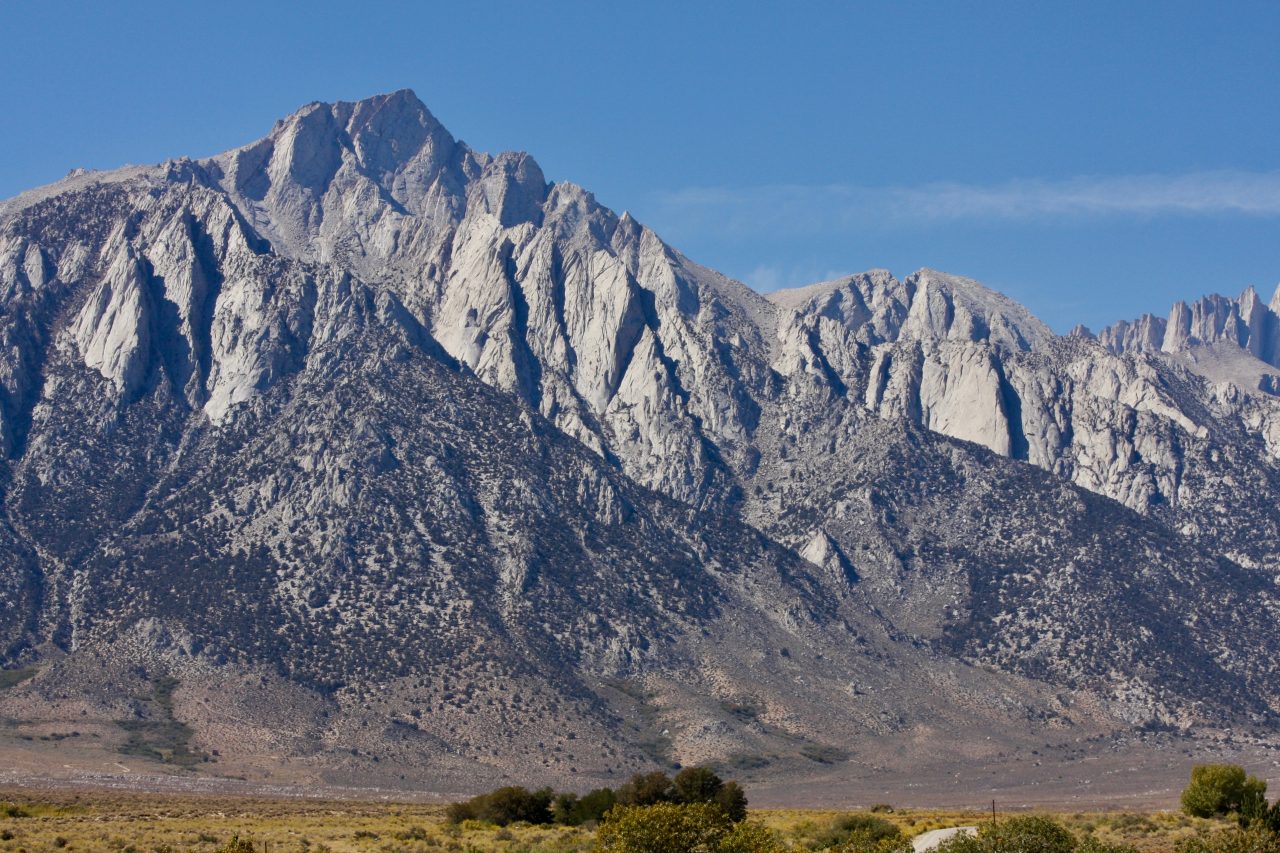
In the opening scenes a Southern Pacific streamliner with Macreedy on board hurtles towards the town, racing through the desert with those distinctive craggy hills in the background. For my money, it’s one of the most memorable beginnings to any film.
Also filmed around Lone Pine were The Charge of the Light Brigade, King Solomon’s Mines and The Lives of a Bengal Lancer – set, like Gunga Din, in India’s Northwest frontier and, like it, featuring the misadventures of three British soldiers.
Despite the fame of these and other classics, Lone Pine remains best known for Westerns. Almost every TV Western you can think of was shot there, including The Lone Ranger, Wagon Train, The Virginian, Rawhide (starring a young Clint Eastwood), Have Gun – Will Travel, Hopalong Cassidy, Champion the Wonder Horse, Alias Smith and Jones, and loads more.
The movie roster includes How the West Was Won, Joe Kidd, The Gunfighter, The Hired Gun, The Cimarron Kid, Frontier Marshall, Wagons Westward… you get the picture?
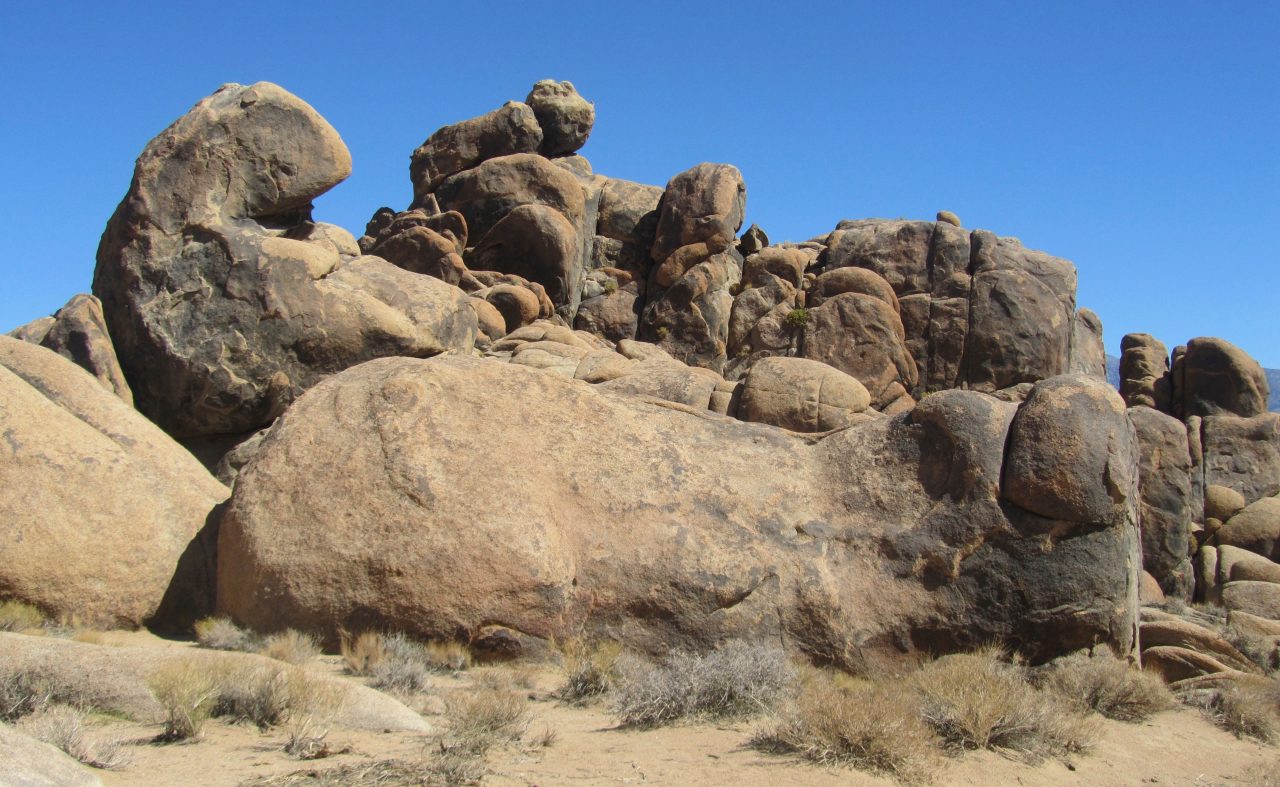
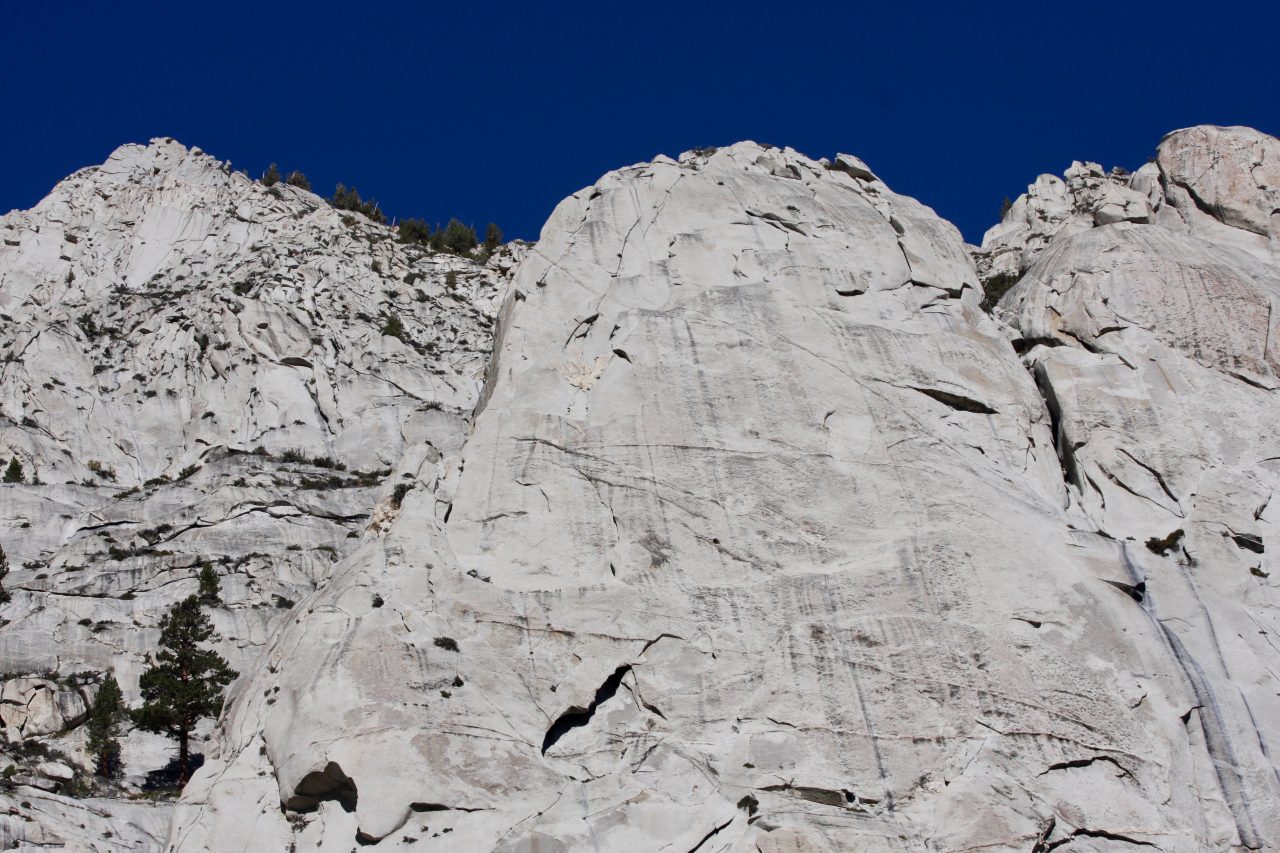
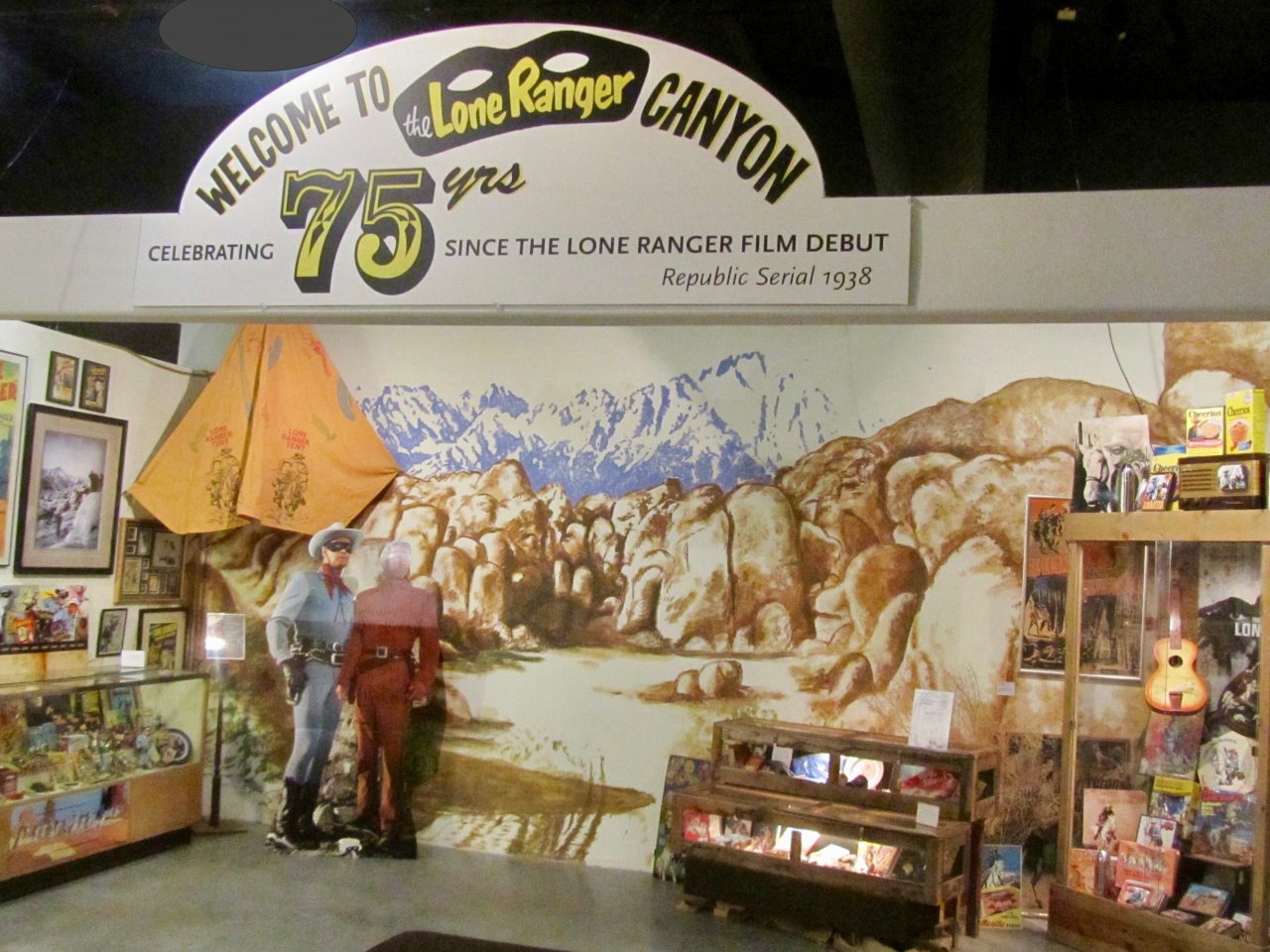
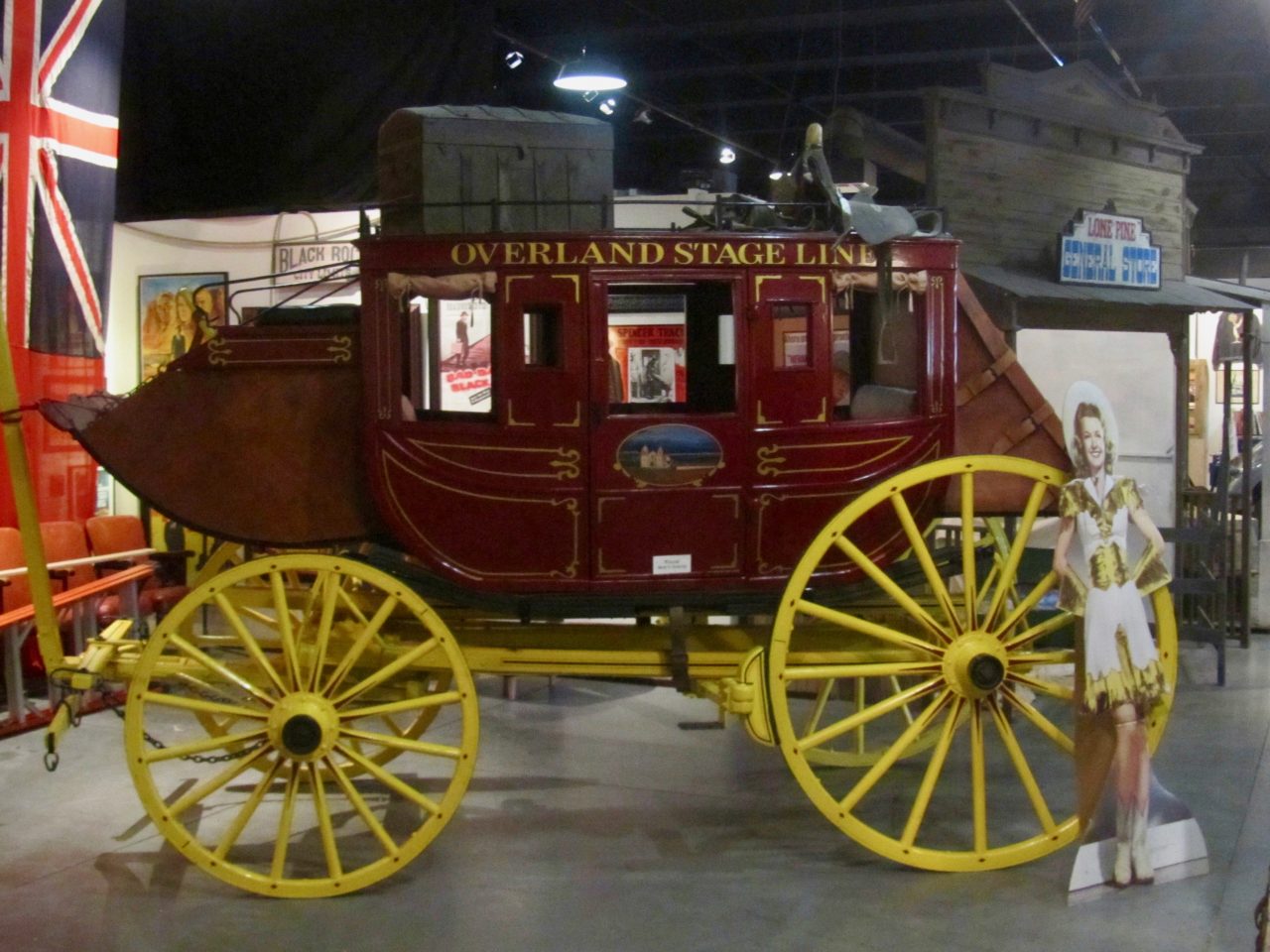
The Western tradition has continued in recent years. Quentin Tarantino’s 2012 Django Unchained and some scenes in the ill-advised 2013 Johnny Depp remake of The Lone Ranger were filmed around Lone Pine. Perhaps the only classy thing about the latter was that it shared this location with the original film and TV series.
Many posters, costumes, props and other items from the movies can be seen at the excellent Museum of Western Film History in Lone Pine. There’s the 1937 Plymouth Coupe driven by Bogart in High Sierra, and the dentist’s coach with a giant tooth on the roof that appears in Django Unchained (pictured with Sue) – it was donated by Tarantino.


Other cinema greats who appeared in films made at Lone Pine include James Stewart, John Wayne, Gregory Peck, Henry Fonda, Ronald Reagan, David Niven, Tony Curtis, Natalie Wood, and Jack Lemmon.
Of course, all those stars and the film crews had to stay somewhere. Many lodged at Lone Pine’s Dow Hotel, founded in 1923 by Walter Dow, a resident who saw that the nascent film industry could become a money-spinner for the town. Motel units were added in 1957.
Another key figure was rancher Russell Spainhower, who for many years acted as a fixer for the studios. His role is recalled on a plaque in the town: “‘We need 50 horses and 10 wagons next week’, they’d say and Spainhower would arrange it, plus help finding locations and hire local riders for the posses.” He used parts of the Gunga Din set to build a permanent mission-hacienda set at his ranch, and added a Western street.
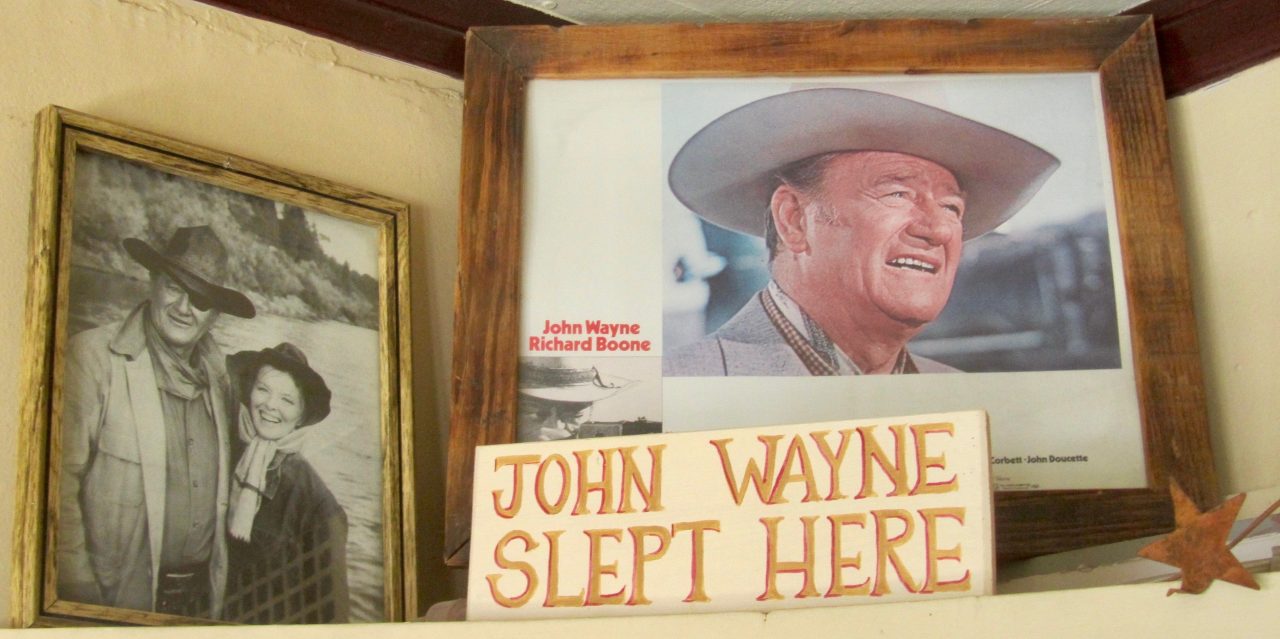

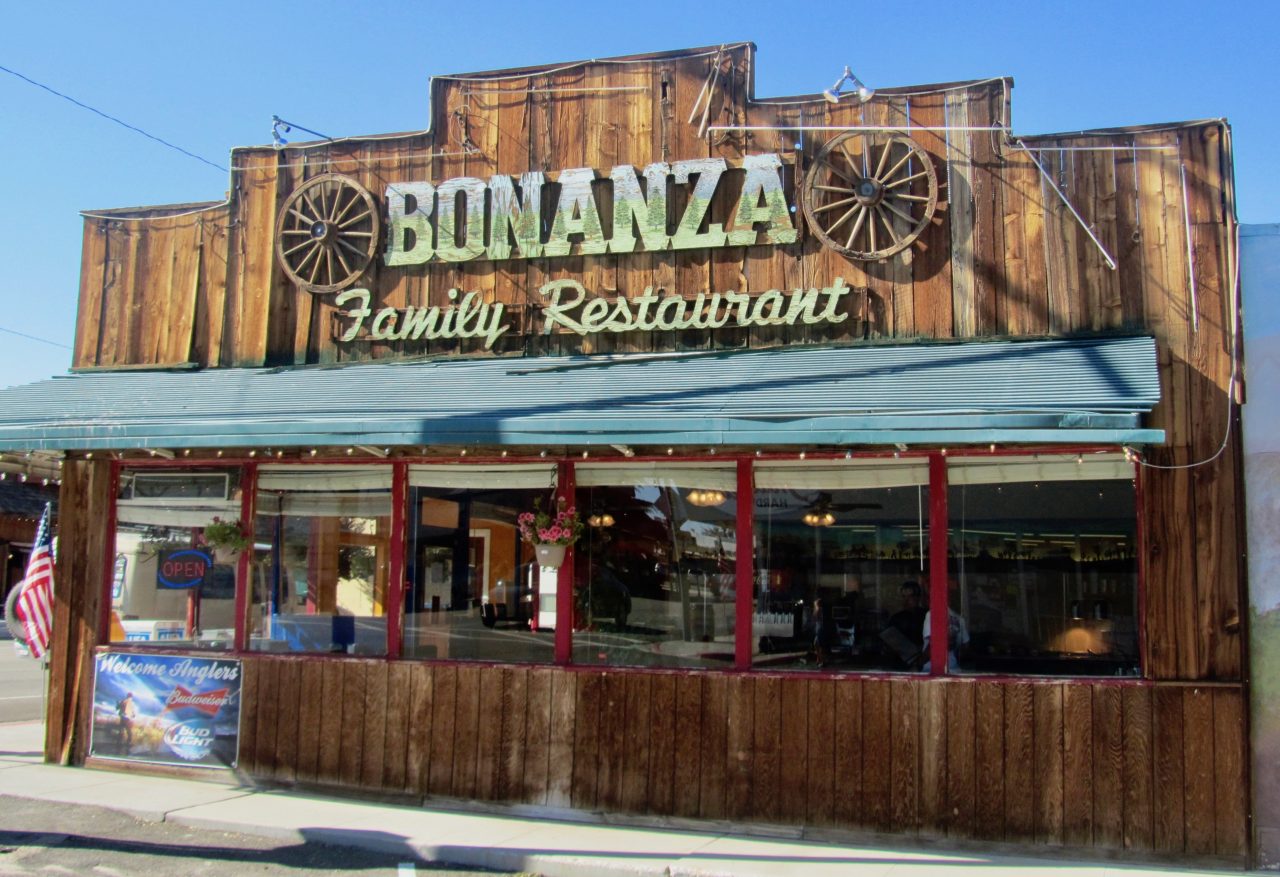
Lone Pine, in the Owens Valley, was founded in the 1860s, when it supplied provisions to miners. It was named after a single pine that grew nearby and was later destroyed by a flood. In 1872, the town was devastated by a large earthquake.
It stages the annual Lone Pine Film Festival, with an 80th anniversary showing of Gunga Din among other screenings at the most recent edition. Other highlights included a parade, a cowboy church service and a closing campfire. Celebrities attending included Patrick Wayne – the 80-year-old actor son of John Wayne – and Robert Carradine, who appeared in TV’s Bonanza and Martin Scorsese’s Mean Streets.
You can drive up a picturesque approach road to the trailhead at the base of the mountains, where you’ll find a car park with signs warning that this is bear country. Bogart is seen fleeing along this road in the museum’s Plymouth in High Sierra.
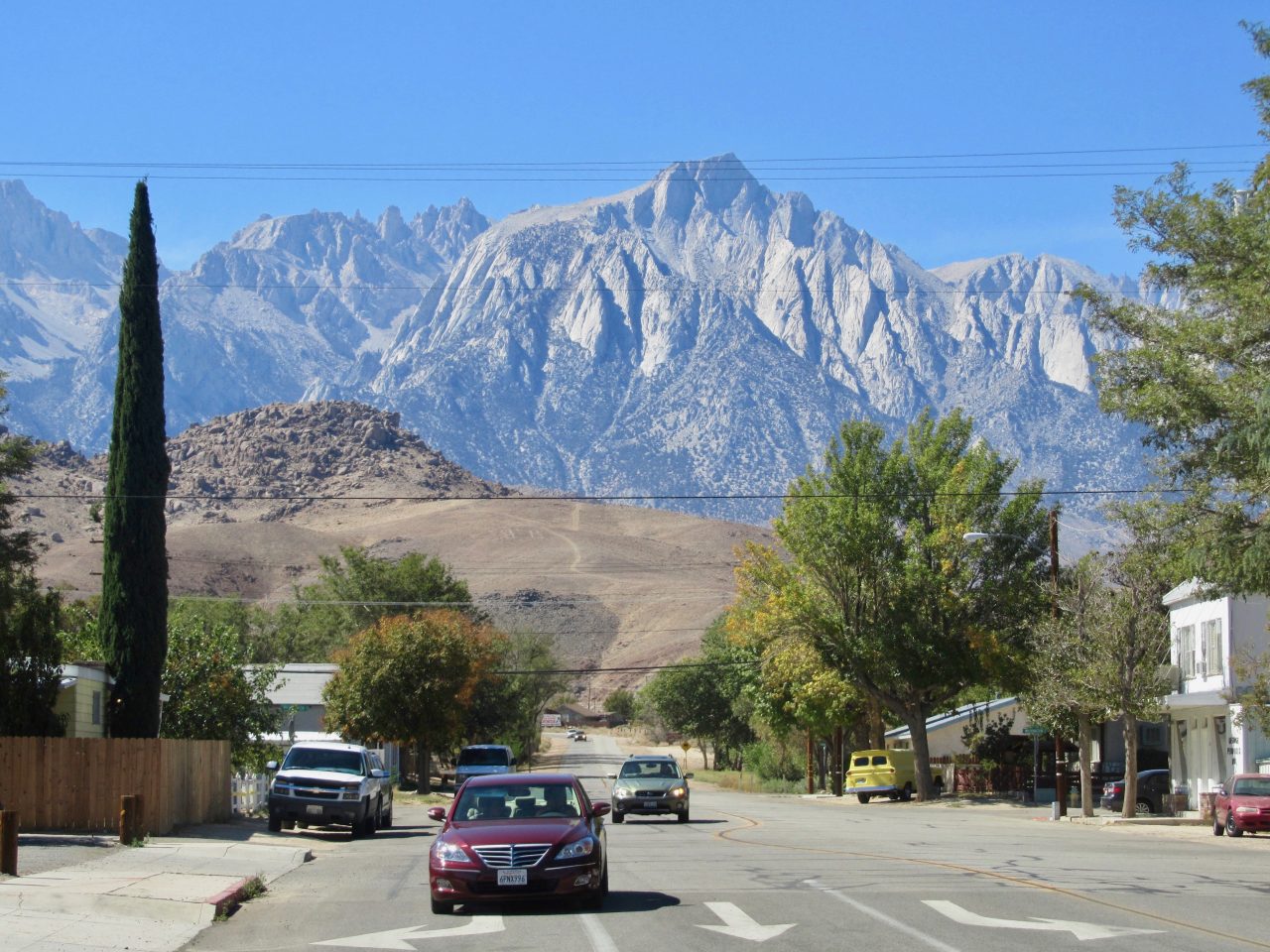
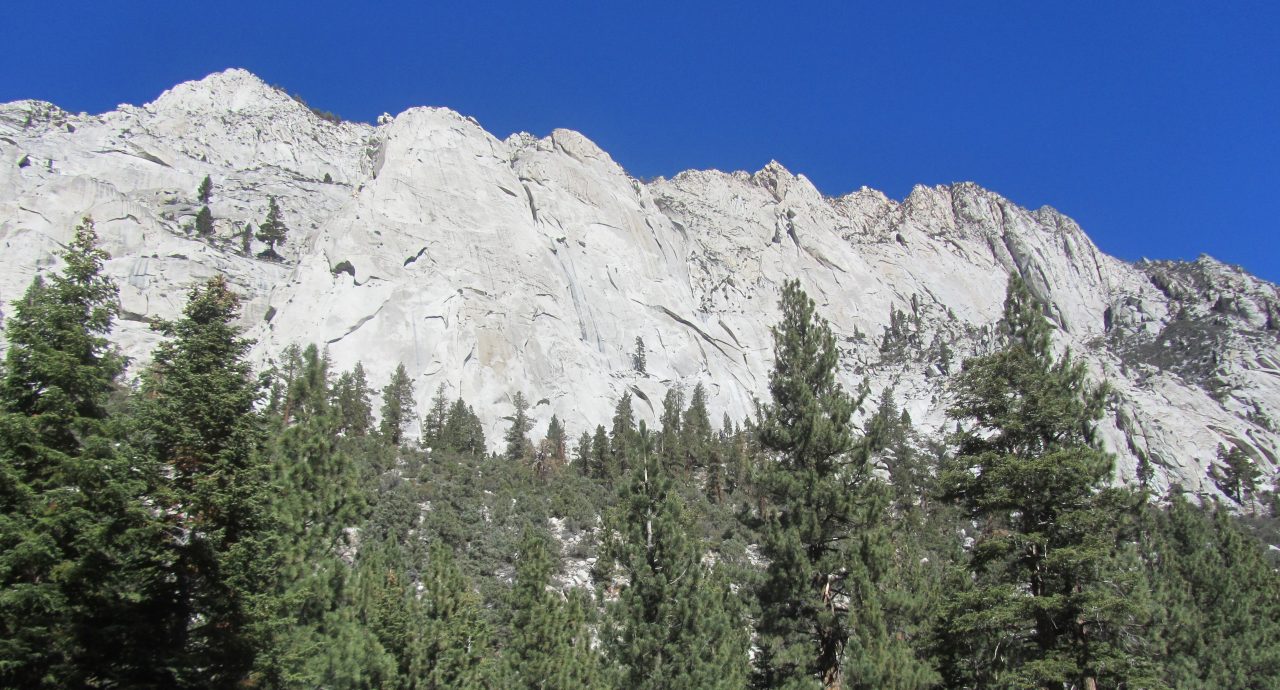
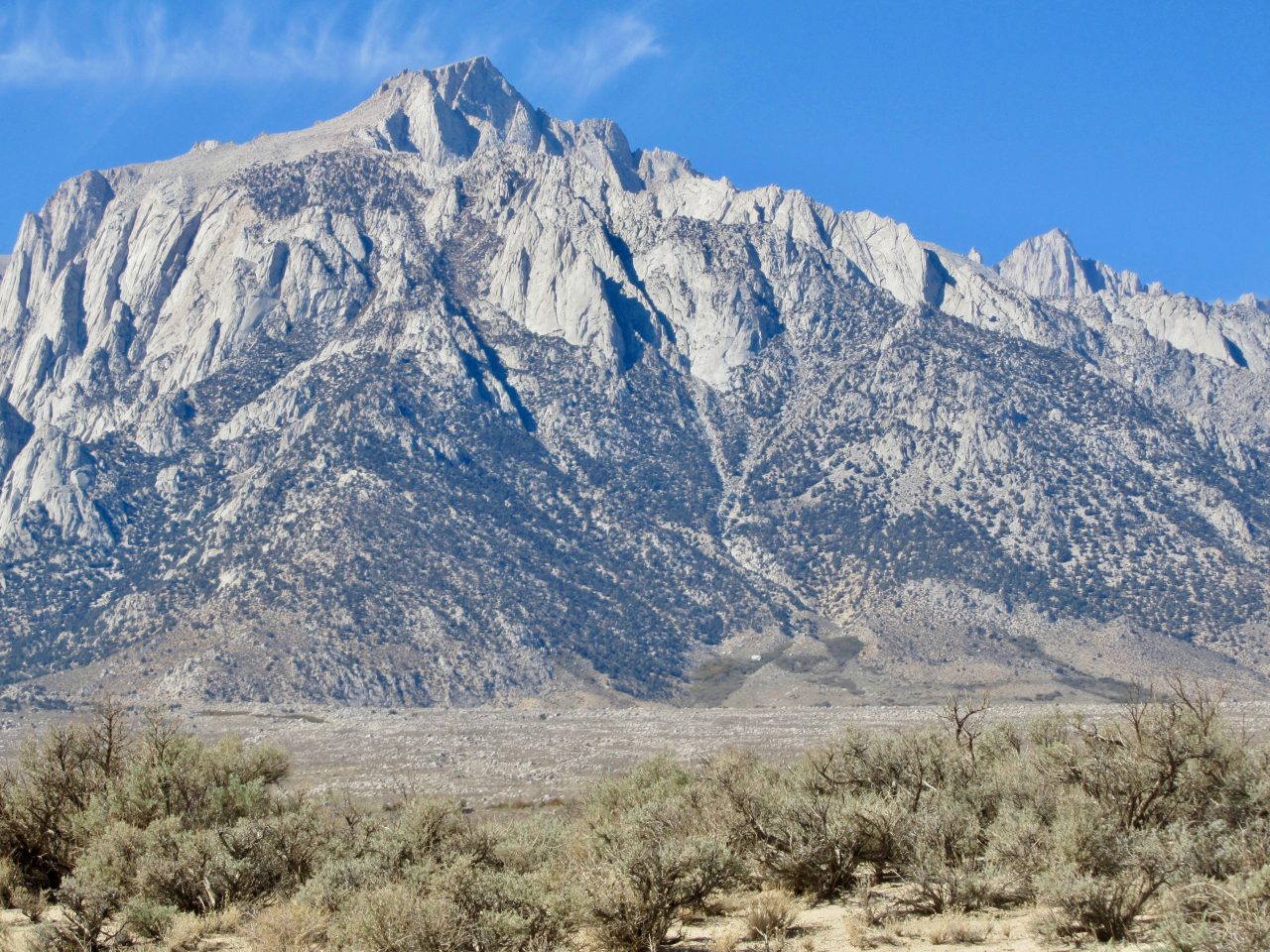
In Bad Day at Black Rock, Tracy’s truth-seeker is initially told Komoko has been interred because of the Second World War – the film is set in 1945. There is, as it happens, a former camp at Manzanar near Lone Pine, one of ten where more than 110,000 Japanese-Americans were interred during the war. It is now a national historic site, and visitors can see reconstructed barracks, a mess hall and a watchtower.
A commemorative plaque bears the words: “May the injustices and humiliation suffered here as a result of hysteria, racism and economic exploitation never emerge again.” Stopping off there, after all the make-believe around Lone Pine, makes for a sobering experience.
Updated March 2021
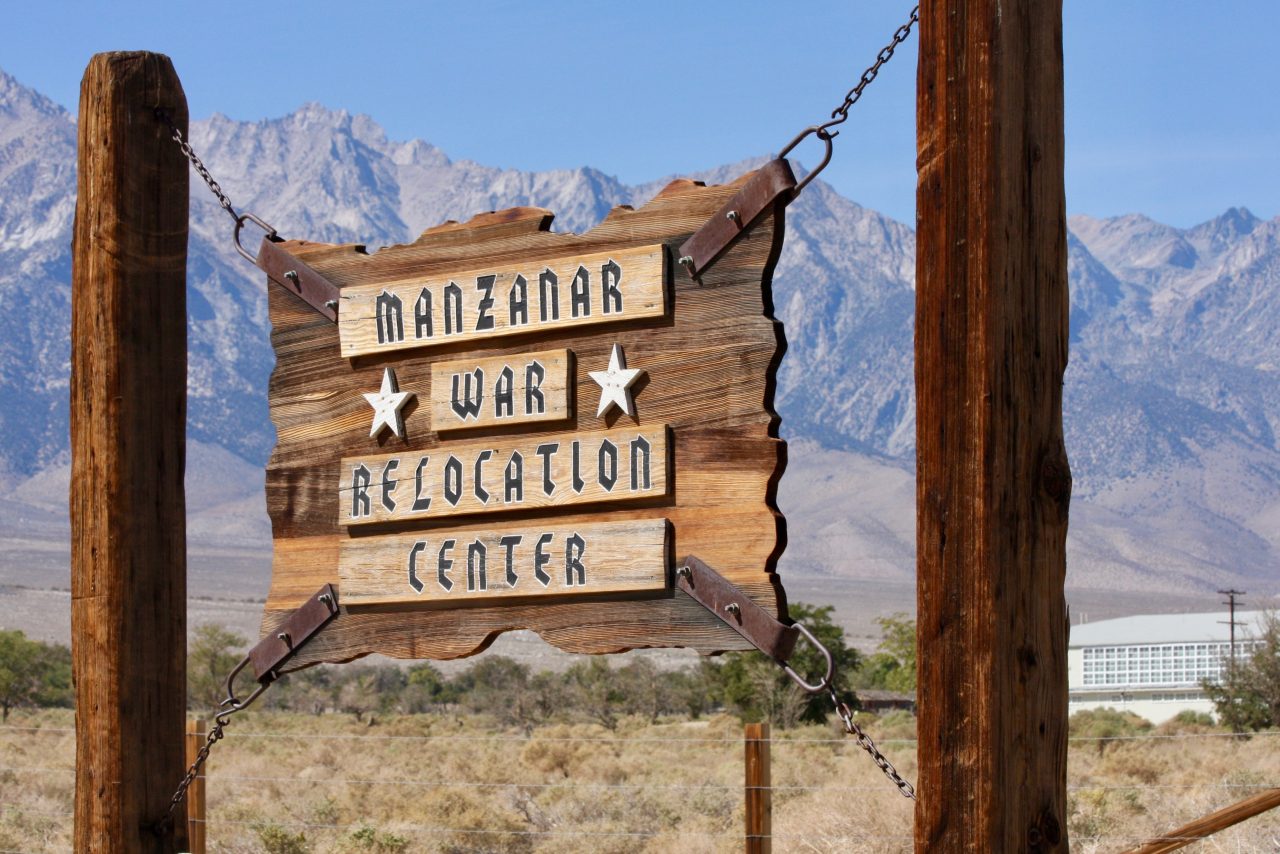
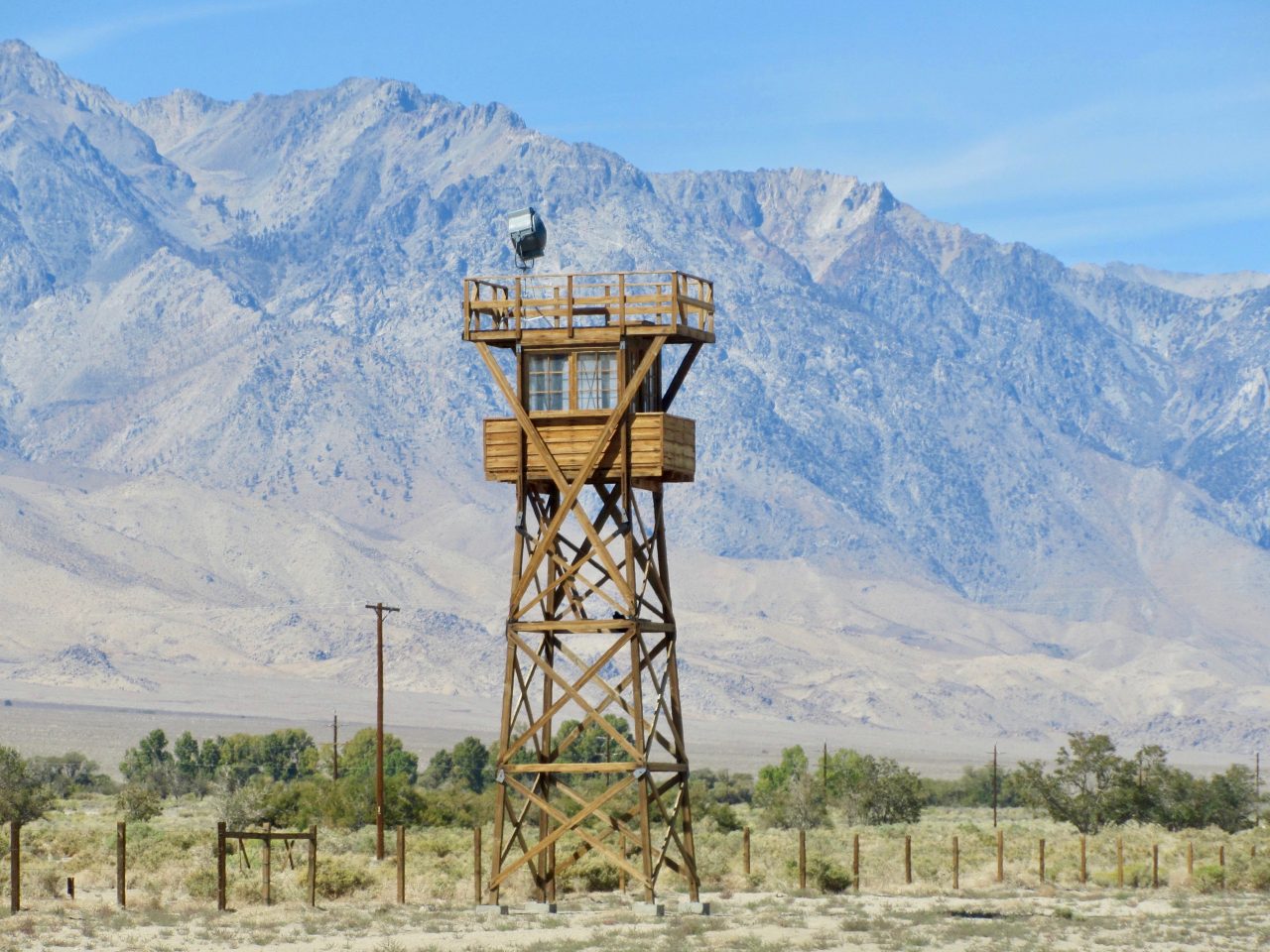
MORE IN THIS SERIES
MORE IN THIS SERIES
MORE INFO
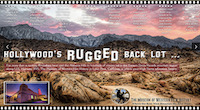 THE MUSEUM of Western Film History’s site is a labour-of-love affair packed with information, trivia and details of special events. READ MORE
THE MUSEUM of Western Film History’s site is a labour-of-love affair packed with information, trivia and details of special events. READ MORE
RELATED
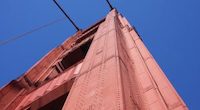 GLORIOUS GOLDEN GATE: You can’t take your eyes off it, and in real life it’s more beautiful than any photograph you can take. The Golden Gate Bridge really does prove that, now and then, mankind can rise above itself… READ MORE
GLORIOUS GOLDEN GATE: You can’t take your eyes off it, and in real life it’s more beautiful than any photograph you can take. The Golden Gate Bridge really does prove that, now and then, mankind can rise above itself… READ MORE
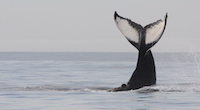 CALIFORNIA’S AMAZING WILDLIFE – GALLERY: Whales, elephant seals, elk, sea lions… California has all these and much, much more. But did you know that you can also find zebras grazing on the roadside in one part of the Golden State? READ MORE
CALIFORNIA’S AMAZING WILDLIFE – GALLERY: Whales, elephant seals, elk, sea lions… California has all these and much, much more. But did you know that you can also find zebras grazing on the roadside in one part of the Golden State? READ MORE
RECOMMENDED
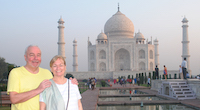 WELCOME TO OUR WORLD! Afaranwide’s home page – this is where you can find out about our latest posts and other highlights. READ MORE
WELCOME TO OUR WORLD! Afaranwide’s home page – this is where you can find out about our latest posts and other highlights. READ MORE
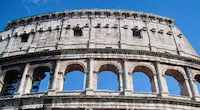 TOP 10 ATTRACTIONS: Many of the world’s most popular tourists sites are closed because of the coronavirus crisis, but you can still visit them virtually while you’re self-isolating. READ MORE
TOP 10 ATTRACTIONS: Many of the world’s most popular tourists sites are closed because of the coronavirus crisis, but you can still visit them virtually while you’re self-isolating. READ MORE
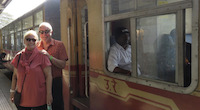 SHIMLA, QUEEN OF THE HILLS: Government officials once retreated to Shimla in the foothills of the Himalayas to escape India’s blazing hot summers. Now tourists make the same journey. READ MORE
SHIMLA, QUEEN OF THE HILLS: Government officials once retreated to Shimla in the foothills of the Himalayas to escape India’s blazing hot summers. Now tourists make the same journey. READ MORE
 TEN THINGS WE LEARNED: Our detailed guide to creating a website, one step at a time. The costs, the mistakes – it’s what we wish we’d known when we started blogging. READ MORE
TEN THINGS WE LEARNED: Our detailed guide to creating a website, one step at a time. The costs, the mistakes – it’s what we wish we’d known when we started blogging. READ MORE
 TROUBLED TIMES FOR EXPATS: Moving abroad can seem an idyllic prospect, but what happens when sudden upheavals or the inescapable realities of life intrude? READ MORE
TROUBLED TIMES FOR EXPATS: Moving abroad can seem an idyllic prospect, but what happens when sudden upheavals or the inescapable realities of life intrude? READ MORE
Afaranwide is an affiliate of leading travel operators such as Booking.com and JR Pass. If you purchase through our site we receive, at no additional cost to you, a small commission. We only work with companies we have used and recommend.
LET'S KEEP IN TOUCH!
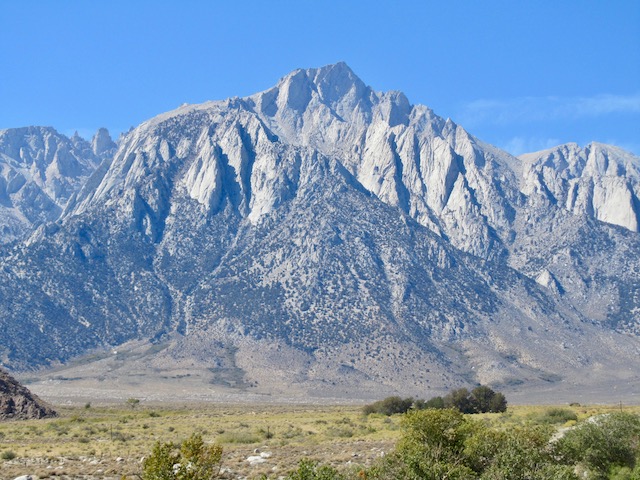
On the Trail in
LONE PINE
Stunning Backdrop For
Hundreds of Westerns

COLIN SIMPSON
YOU may never have heard of the small (pop. 2,035) town of Lone Pine, 320 kilometres north of Los Angeles. But the chances are you’ve seen it and the surrounding area dozens of times on screen. For more than a century, directors, crews and Hollywood’s greatest stars have headed there to shoot some of the best-loved films and TV shows ever made.
They are attracted by the Alabama Hills to the west of the town. Cinematographers love the way the rugged hills, standing east of the Sierra Nevada, fill the frame, providing a striking backdrop to shootouts, chases and other action scenes. Boulder-strewn sites and unusual rock formations provide variety.
TOP PHOTO: Lone Pine Peak dominates the skyline.

Last year saw the centenary of the release of the Western The Round-Up, the first movie to be shot in the area. Lone Pine soon became a favourite location for films about the wild west, though it has also provided backdrops for science fiction epics, comic book blockbusters, thrillers, crime capers, dramas and even sagas about Ancient Rome.
The Internet Movie Database lists no fewer than 502 productions that were shot there. More recent standouts include Gladiator, Iron Man – where it stood in for Afghanistan – Man of Steel, Gone In 60 Seconds, Transformers: Revenge of the Fallen, Chaplin, and two Star Trek films. The many TV series on the list include one of my favourites from the 1960s, The Time Tunnel.
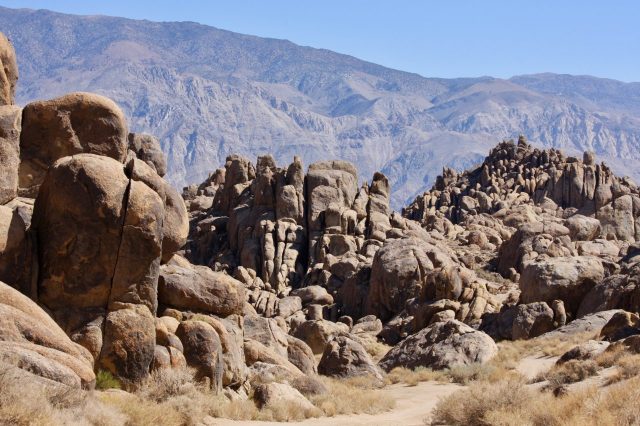
Older classics include 1939’s Gunga Din, where those versatile hills were used to portray the Northwest frontier of India. Stars Cary Grant and Douglas Fairbanks Jr. propelled this comedy adventure to box-office success, and it remains popular 80 years later, scoring 92 percent on Rotten Tomatoes.
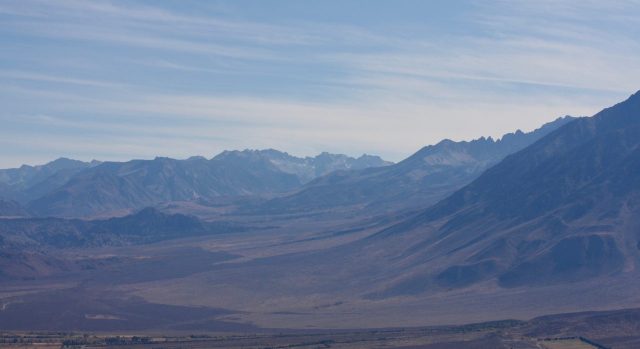
A tourist map is available so you can drive around and stop off at sites where parts of particular films were shot.
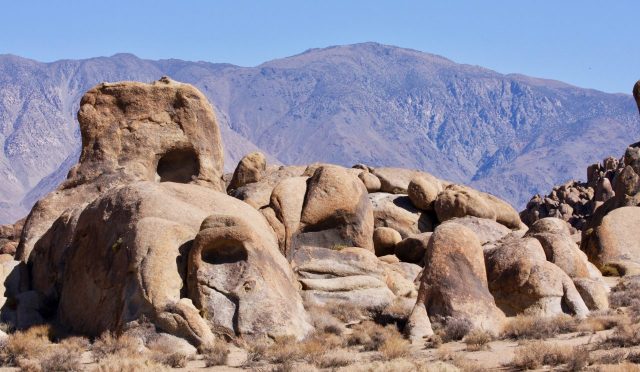
Another film, 1941’s High Sierra, has an even better ranking, 95 percent, and is the movie that turned Humphrey Bogart into a major star. The climax sees “Mad Dog” Roy Earle, played by Bogart, slide to his death from one of the sierra mountains during a shootout.

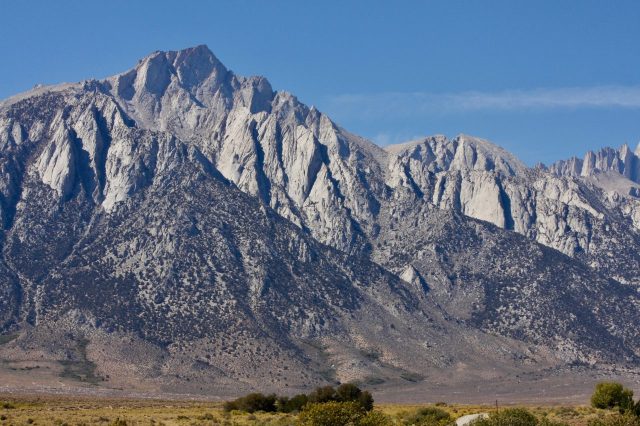

In the opening scenes a Southern Pacific streamliner with Macreedy on board hurtles towards the town, racing through the desert with those distinctive craggy hills in the background. For my money, it’s one of the most memorable beginnings to any film.
Also filmed around Lone Pine were The Charge of the Light Brigade, King Solomon’s Mines and The Lives of a Bengal Lancer – set, like Gunga Din, in India’s Northwest frontier and, like it, featuring the misadventures of three British soldiers.
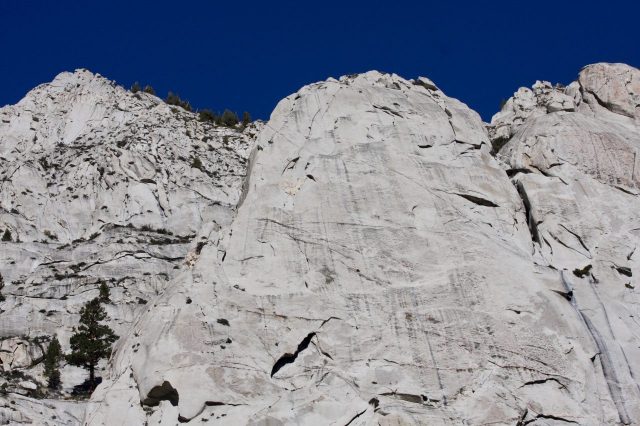

Despite the fame of these and other classics, Lone Pine remains best known for Westerns. Almost every TV Western you can think of was shot there, including The Lone Ranger, Wagon Train, The Virginian, Rawhide (starring a young Clint Eastwood), Have Gun – Will Travel, Hopalong Cassidy, Champion the Wonder Horse, Alias Smith and Jones, and loads more.
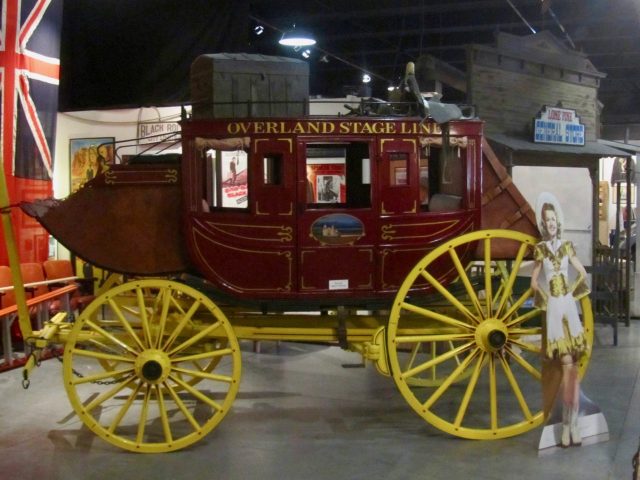
The movie roster includes How the West Was Won, Joe Kidd, The Gunfighter, The Hired Gun, The Cimarron Kid, Frontier Marshall, Wagons Westward… you get the picture?
The Western tradition has continued in recent years. Quentin Tarantino’s 2012 Django Unchained and some scenes in the ill-advised 2013 Johnny Depp remake of The Lone Ranger were filmed around Lone Pine. Perhaps the only classy thing about the latter was that it shared this location with the original film and TV series.

Many posters, costumes, props and other items from the movies can be seen at the excellent Museum of Western Film History in Lone Pine. There’s the 1937 Plymouth Coupe driven by Bogart in High Sierra, and the dentist’s coach with a giant tooth on the roof that appears in Django Unchained (pictured with Sue) – it was donated by Tarantino.

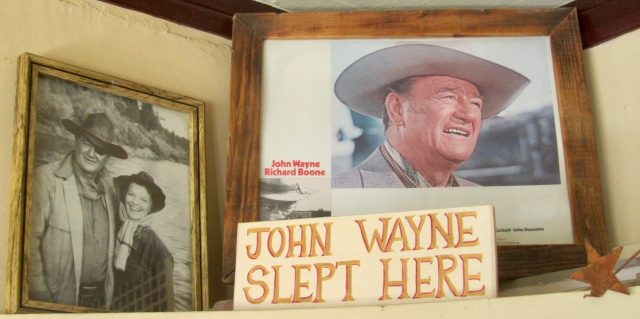
Other cinema greats who appeared in films made at Lone Pine include James Stewart, John Wayne, Gregory Peck, Henry Fonda, Ronald Reagan, David Niven, Tony Curtis, Natalie Wood, and Jack Lemmon.
Of course, all those stars and the film crews had to stay somewhere. Many lodged at Lone Pine’s Dow Hotel, founded in 1923 by Walter Dow, a resident who saw that the nascent film industry could become a money-spinner for the town. Motel units were added in 1957.
Another key figure was rancher Russell Spainhower, who for many years acted as a fixer for the studios. His role is recalled on a plaque in the town: “‘We need 50 horses and 10 wagons next week’, they’d say and Spainhower would arrange it, plus help finding locations and hire local riders for the posses.” He used parts of the Gunga Din set to build a permanent mission-hacienda set at his ranch, and added a Western street.
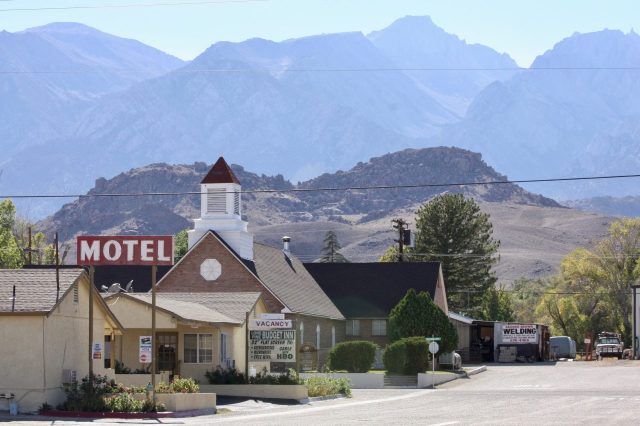

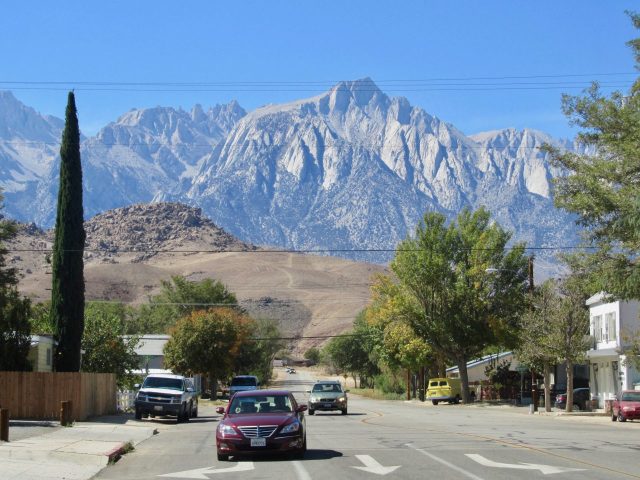
Lone Pine, in the Owens Valley, was founded in the 1860s, when it supplied provisions to miners. It was named after a single pine that grew nearby and was later destroyed by a flood. In 1872, the town was devastated by a large earthquake.
It stages the annual Lone Pine Film Festival, with an 80th anniversary showing of Gunga Din among other screenings at the most recent edition. Other highlights included a parade, a cowboy church service and a closing campfire. Celebrities attending included Patrick Wayne – the 80-year-old actor son of John Wayne – and Robert Carradine, who appeared in TV’s Bonanza and Martin Scorsese’s Mean Streets.
You can drive up the picturesque approach road to the trailhead at the base of Mount Whitney, where you’ll find a car park with signs warning that this is bear country. Bogart is seen fleeing along this road in the museum’s Plymouth in High Sierra.
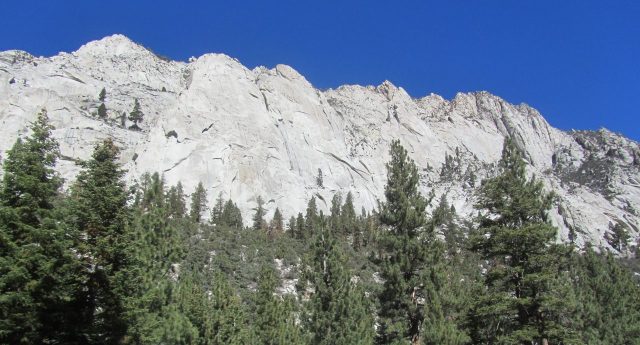
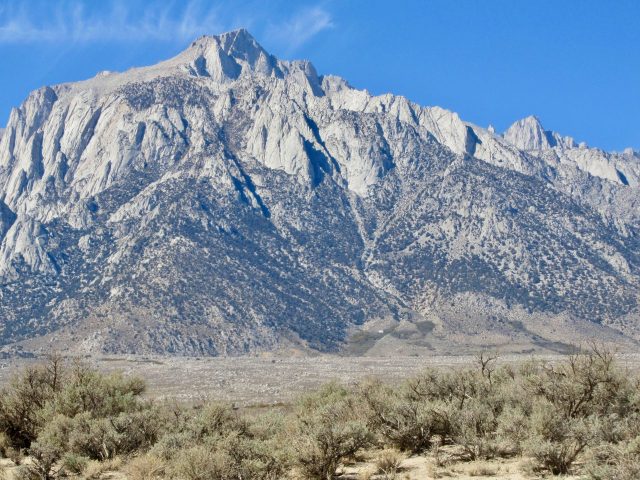
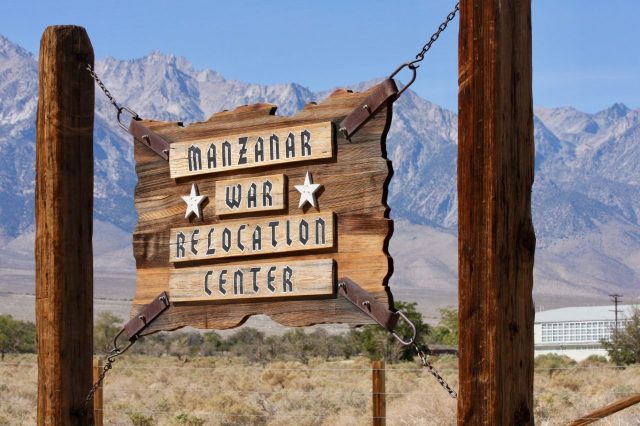
In Bad Day at Black Rock, Tracy’s truth-seeker is initially told Komoko has been interred because of the Second World War – the film is set in 1945. There is, as it happens, a former camp at Manzanar near Lone Pine, one of ten where more than 110,000 Japanese-Americans were interred during the war. It is now a national historic site, and visitors can see reconstructed barracks, a mess hall and a watchtower.
A commemorative plaque bears the words: “May the injustices and humiliation suffered here as a result of hysteria, racism and economic exploitation never emerge again.” Stopping off there, after all the make-believe around Lone Pine, makes for a sobering experience.
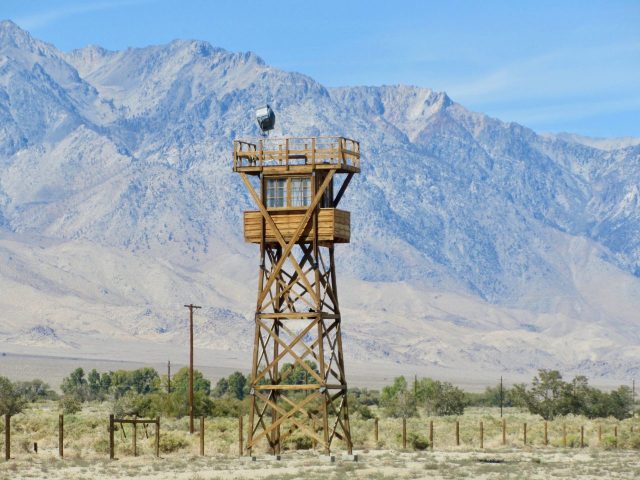
Updated March 2021
MORE IN THIS SERIES
Escape to Alcatraz for a Day
Death Valley, Where the Star Wars Saga Began
Hollywood’s Scariest Church, Schoolhouse
Greeted by Yoda, We Were
MORE INFO
 THE MUSEUM of Western Film History’s site is a labour-of-love affair packed with information, trivia and details of special events. READ MORE
THE MUSEUM of Western Film History’s site is a labour-of-love affair packed with information, trivia and details of special events. READ MORE
RELATED
 GLORIOUS GOLDEN GATE: You can’t take your eyes off it, and in real life it’s more beautiful than any photograph you can take. The Golden Gate Bridge really does prove that, now and then, mankind can rise above itself… READ MORE
GLORIOUS GOLDEN GATE: You can’t take your eyes off it, and in real life it’s more beautiful than any photograph you can take. The Golden Gate Bridge really does prove that, now and then, mankind can rise above itself… READ MORE
 CALIFORNIA’S AMAZING WILDLIFE – GALLERY: Whales, elephant seals, elk, sea lions… California has all these and much, much more. But did you know that you can also find zebras grazing on the roadside in one part of the Golden State? READ MORE
CALIFORNIA’S AMAZING WILDLIFE – GALLERY: Whales, elephant seals, elk, sea lions… California has all these and much, much more. But did you know that you can also find zebras grazing on the roadside in one part of the Golden State? READ MORE
RECOMMENDED
 WELCOME TO OUR WORLD! Afaranwide’s home page – this is where you can find out about our latest posts and other highlights. READ MORE
WELCOME TO OUR WORLD! Afaranwide’s home page – this is where you can find out about our latest posts and other highlights. READ MORE
 TOP 10 ATTRACTIONS: Many of the world’s most popular tourists sites are closed because of the coronavirus crisis, but you can still visit them virtually while you’re self-isolating. READ MORE
TOP 10 ATTRACTIONS: Many of the world’s most popular tourists sites are closed because of the coronavirus crisis, but you can still visit them virtually while you’re self-isolating. READ MORE
 SHIMLA, QUEEN OF THE HILLS: Government officials once retreated to Shimla in the foothills of the Himalayas to escape India’s blazing hot summers. Now tourists make the same journey. READ MORE
SHIMLA, QUEEN OF THE HILLS: Government officials once retreated to Shimla in the foothills of the Himalayas to escape India’s blazing hot summers. Now tourists make the same journey. READ MORE
 TEN THINGS WE LEARNED: Our detailed guide to creating a website, one step at a time. The costs, the mistakes – it’s what we wish we’d known when we started blogging. READ MORE
TEN THINGS WE LEARNED: Our detailed guide to creating a website, one step at a time. The costs, the mistakes – it’s what we wish we’d known when we started blogging. READ MORE
 TROUBLED TIMES FOR EXPATS: Moving abroad can seem an idyllic prospect, but what happens when sudden upheavals or the inescapable realities of life intrude? READ MORE
TROUBLED TIMES FOR EXPATS: Moving abroad can seem an idyllic prospect, but what happens when sudden upheavals or the inescapable realities of life intrude? READ MORE
Afaranwide is an affiliate of leading travel operators such as Booking.com and JR Pass. If you purchase through our site we receive, at no additional cost to you, a small commission. We only work with companies we have used and recommend.

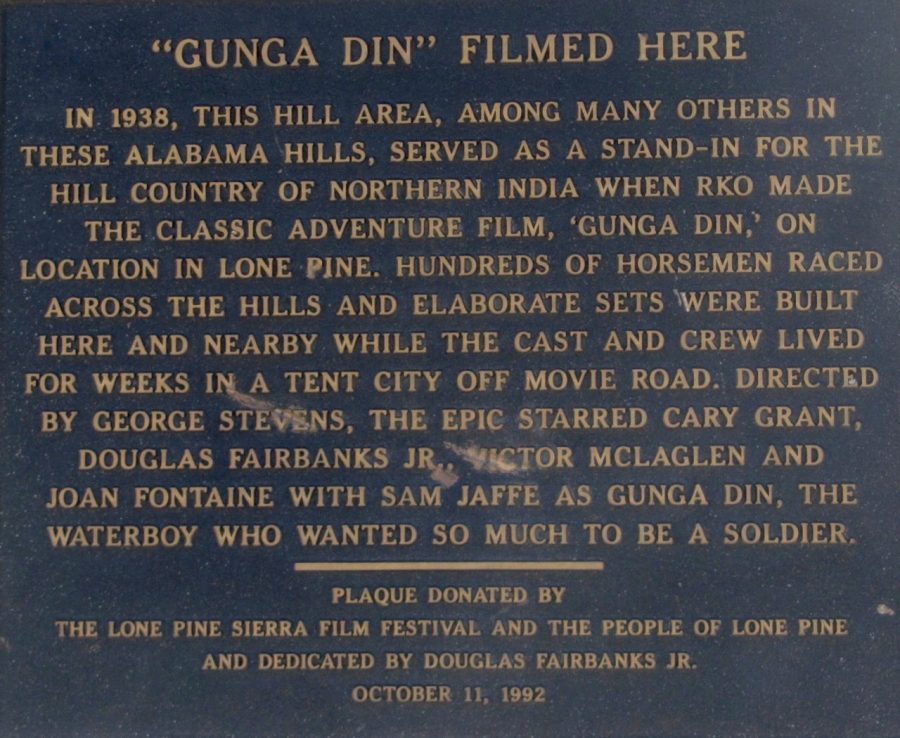
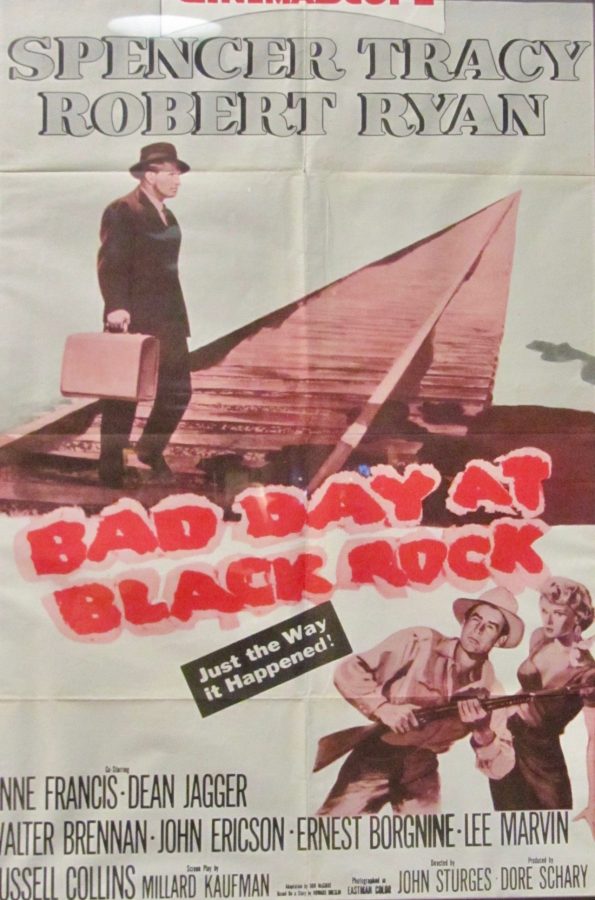
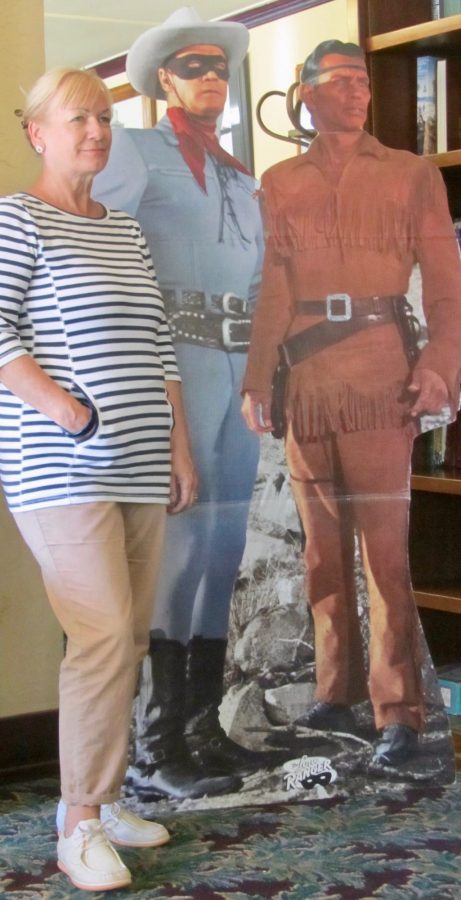
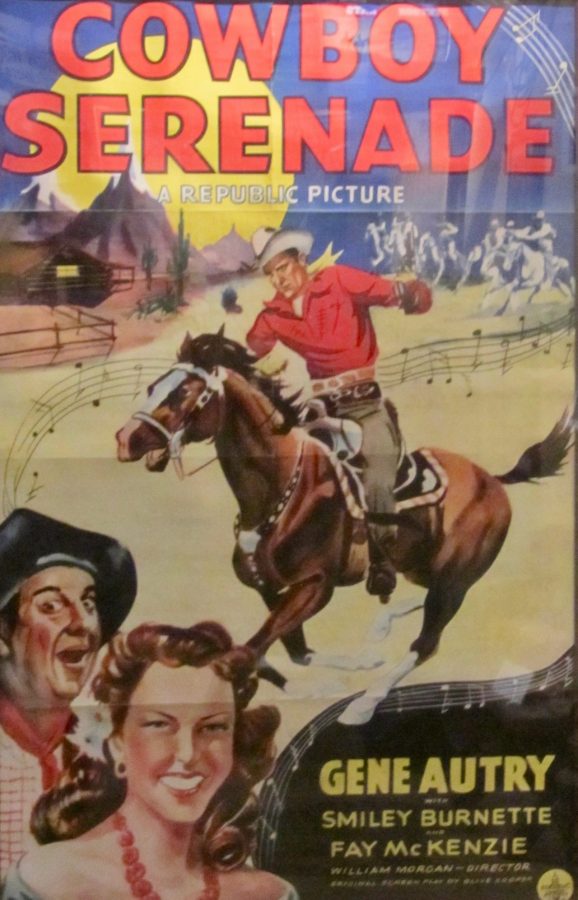
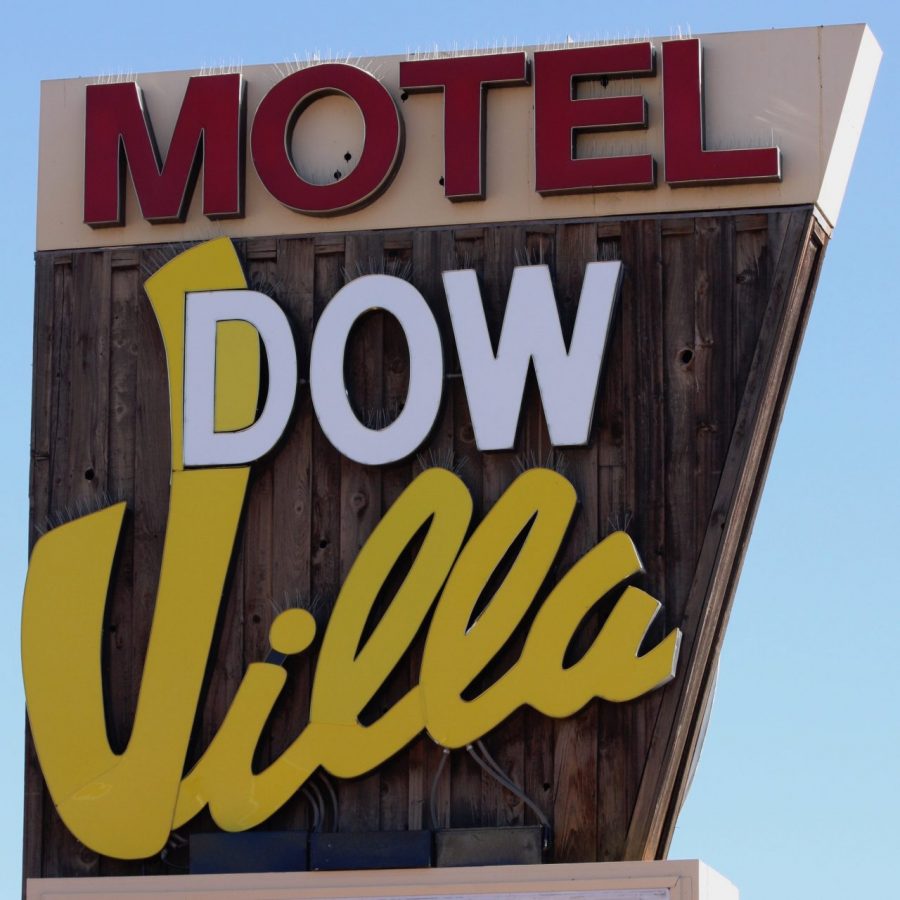

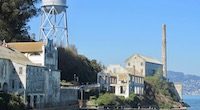
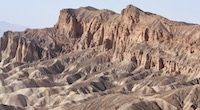
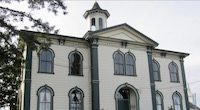




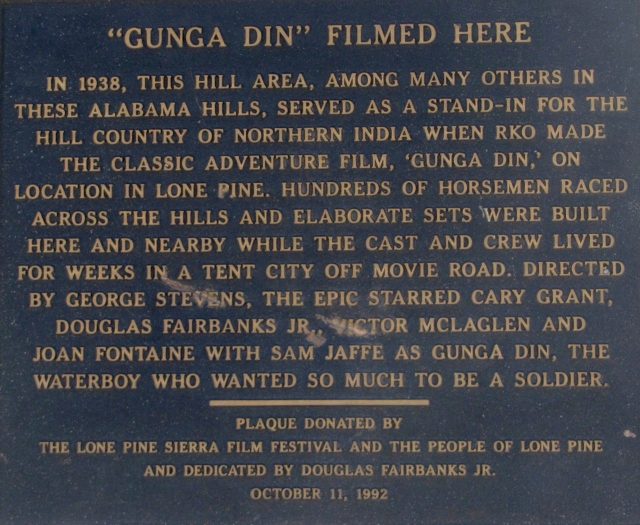


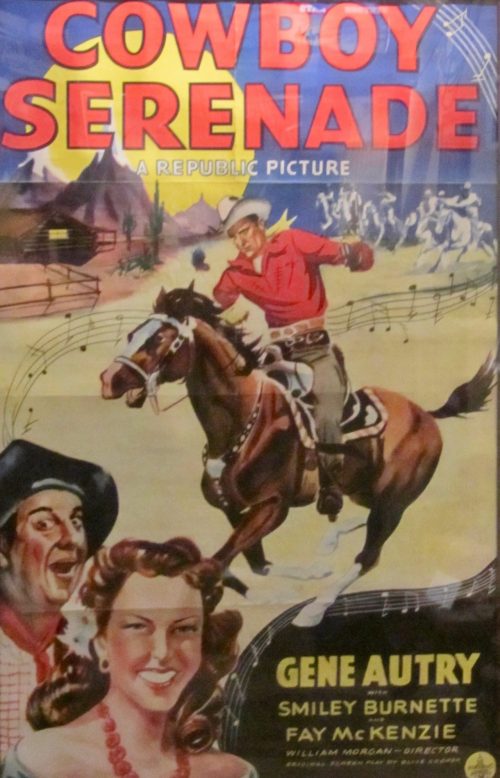
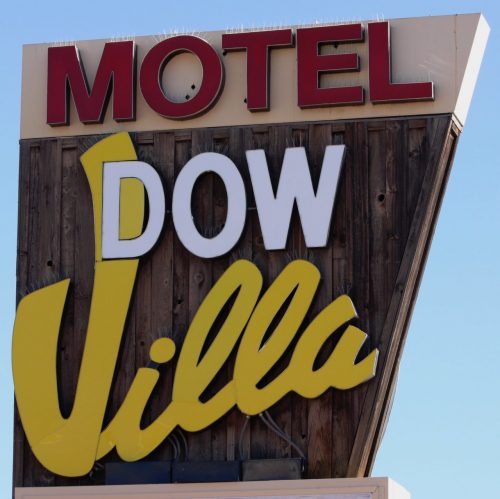


My uncle and Grandmother bought homes and lived in Lone Pine when I was very young. I don’t remember much about it, other than my father called it a Ghost Town. My memories include a one cell jail house, the only store was also the post office and if I am correct it was also attached or next door to the one room school house. Oh, and I think you could see Mt. Whitney from my Grandmother’s house. It’s been at least 60 years since I was last there. My uncle and Grandmother are now gone, maybe their ghosts have… Read more »
Hi Cynthia, thanks for sharing your memories, that’s great. We found LP a fascinating place to visit, but maybe a bit quiet if you lived there!
Awesome post guys! This place looks SO similar to Cappadocia in Turkey, where I visited this past year. Note all the fairy chimney structures.
Ryan
Congrats for all your travels, your work, and pictures !!!!